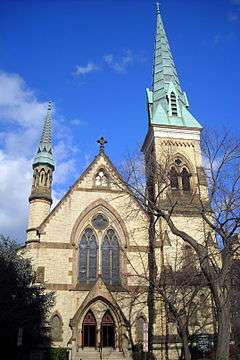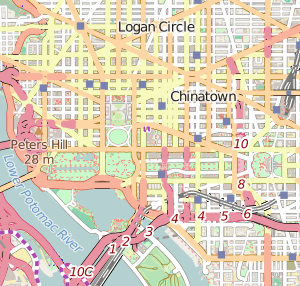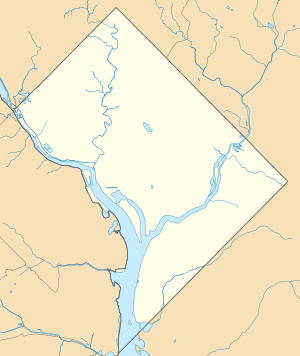Church of the Ascension and Saint Agnes
| Church of the Ascension and Saint Agnes | |
|---|---|
|
| |
| Basic information | |
| Location |
1215 Massachusetts Avenue NW Washington, D.C. |
| Affiliation | Episcopal Church in the United States of America |
| Status | active |
| Leadership | The Rev. Fr. Dominique Peridans - Priest in Charge |
| Website | www.asa-dc.org |
| Architectural description | |
| Architect(s) | Charles L. Carson, Thomas Dixon |
| Architectural type | church |
| Architectural style | Gothic |
| Completed | 1874 |
| U.S. National Register of Historic Places | |
| Added to NRHP | January 19, 1984 |
| NRHP Reference no. | 84000863[1] |
|
Church of the Ascension | |
 | |
   | |
| Location | 1215 Massachusetts Ave. NW, Washington, District of Columbia |
|---|---|
| Coordinates | 38°54′18″N 77°1′43″W / 38.90500°N 77.02861°WCoordinates: 38°54′18″N 77°1′43″W / 38.90500°N 77.02861°W |
| Area | 0.3 acres (0.12 ha) |
| Built | 1874 |
| Architect | Thomas Dixon; Charles L. Carson |
| Architectural style | Gothic |
| NRHP Reference # | 84000863[1] |
| Added to NRHP | January 19, 1984 |
The Church of the Ascension and Saint Agnes is an Episcopal church building located at 1215 Massachusetts Avenue in Northwest Washington, D.C., USA. The current structure built in 1874 as the Church of the Ascension was added to the National Register of Historic Places in 1984.[1] In the late 1940s, the Church of the Ascension merged with the nearby St. Agnes Episcopal Church and adopted its present name, under which it has continued as an active parish in the Episcopal Diocese of Washington.[1][2]
History
On May 7, 1844, several residents of northwest Washington who had previously attended services at St. John's Episcopal Church in the Lafayette Square neighborhood met to begin forming their own parish. The church was formally established March 1, 1845, and the territory of St. John's was split between the two churches. While the church raised funds to construct a building, the members met in a schoolhouse on 9th Street.
Parishioner Martha Burnes was the owner of 600 acres of Washington real estate, which she had inherited. In 1802, she married John Peter Van Ness, who was a prominent banker and later became Mayor of Washington. Among Mrs. Van Ness's philanthropic endeavors was the Washington Orphan Asylum, which she established and supervised. Mrs. Van Ness expressed a desire to help the building effort, but died before this could happen. In accordance with her wishes, Mr. Van Ness donated land on H Street NW between 9th and 10th to Ascension Parish, and the cornerstone was laid September 5, 1844.
The Gothic Revival brick structure was complete enough to use by December 1844, and the first services were held December 14. The debt the parish incurred for construction was repaid by 1853, and the church was consecrated May 23 of that year. Throughout the 1850s, however, the parish continued to experience difficulties, which included the ill health of its rector, Levin I. Gilliss, resignation of his successor, a decline in the number of communicants and Sunday school attendees, and continued financial problems.
The congregation sought the Rev. William Pinkney, who was then rector of St. Matthias Church in nearby Bladensburg, Maryland, to become the next rector. After initial reluctance, Pinkney agreed and the parish stabilized. In 1859, he oversaw building renovations that included expanding the capacity for approximately 600 additional worshipers.
As many parishioners had friends and relatives in both the Northern and Southern states, their feelings and loyalties boiled over in the church during the period leading to and during the Civil War. This division was evident in the clerical ranks also as the rector, Mr Pinkney, sympathized with the South while Maryland Bishop William Whittingham was a Unionist. In March 1862, Bishop Whittingham requested parishes to say a special prayer of thanksgiving for the late (Union) victories; Mr. Pinkney refused.
The Saturday following Pinkney's refusal, Washington's Provost Marshall notified him that the authories would assume control of the church to prevent a disturbance. Ascension became a military hospital to house casualties from the Peninsula Campaign, as did Epiphany Church and Holy Trinity in Washington.
After their church was seized by the government, the parish was without a home. The problem was solved by member William Corcoran, a prominent banker and partner in the firm of Corcoran and Riggs, later known as Riggs Bank. Corcoran offered the use of a building he owned on H Street NW between 13th and 14th Streets.
The congregation returned to its permanent home after the war, but by 1870, the structure proved too small and not grand enough for what was now one of the most affluent areas of the city. After much debate, leaders decided to erect a new structure and began soliciting funds. William Corcoran donated a site at the northwest corner of Massachusetts Avenue and 12th Street and $100,000 of the $205,000 construction costs.
The congregation engaged the Baltimore firm of Dixon and Carson, and the cornerstone was laid June 9, 1874. The new building was constructed of white marble quarried near Cockeysville, Maryland with accents of pink Ohio sandstone. Designed in the Victorian Gothic style, it reached a height of 74 ft (23 m) with a 190 ft (58 m) tower and spire that was visible across much of the city. The interior featured cast iron columns and timber trusses and was illuminated by gas lamps.
Despite the gift of William Corcoran, the church continued to have financial problems and by 1877 was facing the possibility of dissolution. After a plea to its members, the church was able to raise needed funds and received a challenge gift of $10,000 from Corcoran. The construction debt was finally retired in 1885.
In 1895, the Diocese of Washington was created from the Diocese of Maryland and included the District of Columbia and Charles, Montgomery, Prince George's, and St. Mary’s Counties in Maryland. St. Mark’s Church was chosen as the cathedral in 1896. In 1902, Annunciation assumed that role until 1908 when the parish leaders voted to terminate the relationship with the diocese. Although the official designation ceased, the church continued to be used as the pro-cathedral for important occasions until 1912 while the Washington National Cathedral was under construction.
After World War I, membership began to decline, and in 1925 the congregation merged with nearby St. Stephen’s to help stabilize the group. This worked briefly until the onset of the Great Depression. This downturn continued through 1947, and the diocese considered selling the building to another congregation when the Vestry received a proposal to merge from St. Agnes Church.[3]
The interior was redecorated and a mural was added above the chancel. The nave windows and window above the organ gallery were replaced between 1965 and 1975 with faceted glass and epoxy designs created by the Willet Studios of Philadelphia, Pennsylvania.[1]
Today, the church offers worship services, concerts, and a number of outreach groups for members and nearby residents.
The parish
The current parish is a diverse, urban congregation from both the downtown area and the Washington, D.C., metropolitan area. Some parishioners come from Baltimore, Annapolis, and Richmond. It has a 20s and 30s group, including students from nearby Virginia Theological Seminary, who also attend services there.
Services
The main Sunday service is Solemn Mass and sermon with choir and organ, at 10:00 am. Sunday low mass is at 8:00 a.m. Between the two services, adult education and the Rosary are offered at 9:00 am. During the week, Evening Prayer and Low Mass are offered on Wednesdays at 6:45 pm and Eucharistic adoration and Low Mass are offered on Thursdays beginning at 6:30 am.[4]
Ministries
The ministries of the parish include the following:
- Community Groups: Ascension and St. Agnes has two weekly community groups where individuals from the parish and outside come together for a meal and conversation.
- Alpha Course: Alpha Course is a ten-week course introducing the basics of Christianity. Designed for both non-believers and those who would simply like to refresh their faith, it has been taken by some eleven million people worldwide.
- Catechumenate: Catechumenate is the course of preparation used by the church since the 4th century to prepare new Christians for baptism. The course runs from October through April and serves as instruction for those wishing to be baptized, confirmed or received into the Episcopal Church.
- Theology Book Club: A monthly group which studies and discusses various theological works.
- Benedictine cell: Serves as a group to engage those wishing to explore monastic spirituality.
- Bible Study: Bible study is held Sunday mornings at 9:00 a.m.
- Outreach programs: The Parish helps subsidize Christ House, a hospital for the inner city poor and homeless. Christ House is a United Way charity. The parish also participates in the mission of N Street Village, which offers programs for homeless women and low-income families. In addition, Ascension and St. Agnes runs an annual mission trip to San Juan de Oriente, Nicaragua.[4]
See also
References
- 1 2 3 4 5 National Park Service (2009-03-13). "National Register Information System". National Register of Historic Places. National Park Service.
- ↑ Episcopal Diocese of Washington: Find a church
- ↑ "Parish History". ascensionstagnes.org. Retrieved October 26, 2010.
- 1 2 Church of the Ascension and Saint Agnes
External links
- Church of the Ascension and St Agnes
- Christ House
- List of Anglo-Catholic Devotional Societies
- Mystery Worshiper's report